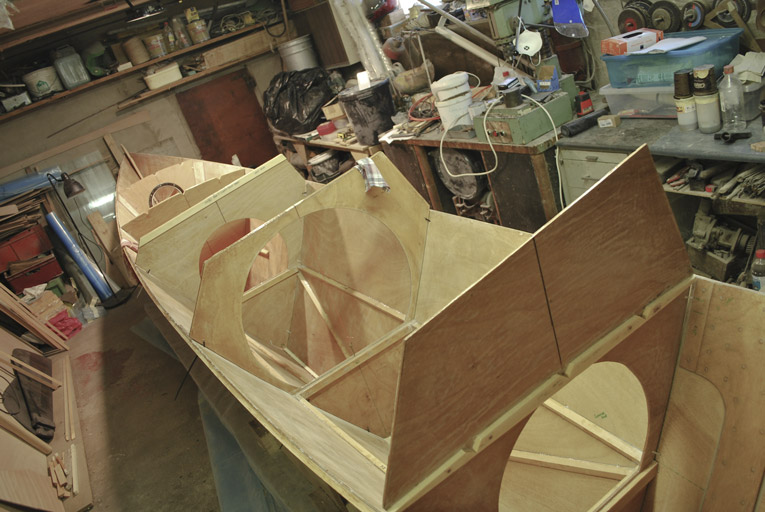So… second hull got stitched up and yesterday I made some nice fillets for keel & bulkheads for 2 sections… I think its time to talk about little variations and changes I have made and plan to make into workflow, just to make whole process a little bit smoother and less time consuming.
- Preparing hullsides – this time after gluing and coating hullsides, I sanded all the surface of inner faces and treated bulkheads likewise, as it was for starboard hull a truly utter PITA to sand them in assembled hull; also I beveled underside corner of sheer stringer with a planer, leaving sheer stringer double locations untouched – comfortable and easy way.
- Nailing – as I have described previously I started using temporary screws or clamps to hold pieces in place during gluing, cause its pretty impossible to get those copper nail heads nicely flush with surface without using sledgehammer. But still occasionally I went for nails, but with variation I drilled ca millimeter deep holes with diameter of nail head for the nails to get nail heads flush with surface, otherwise its not easy later when sanding to maintain epoxy coating on top of the protruding nail heads.
- Stitching – I abandoned the copper wire, using cable ties exclusively. The main reason I used them in first place was my antipathy towards all sorts of single use throwaway plastic products – but then I realized, that environmental cost of messing up with epoxy in some point would be much greater than those few disposed plastic straps. Second consideration was that copper wire is re-adjustable, which it is basically, but only for one or two times, after which it parts. But one will learn quickly not to over tighten the cable tie. Copper wire is little bit easier to tighten, but one learns quickly to fasten the cable tie without putting whole body behind it with a risk to accidentally move pieces to be glued from their desired locations.
Copper wire ties tend to have another nasty habit, that is secretly to tear holes in your protective gloves, and when you have finished gluing, treated your hands with West System epoxy resin removing cream and started cleaning up the mess, then you will realize that there are long painstaking hours ahead cutting wire, filing off protruding leftover parts and fishing out those wires that have buried in their tiny sarcophages of hard rock cured epoxy because you didn’t wipe off excess of the glue properly. - Bunk bearer – like for starboard hull I glued bunk bearers into bulkheads before inserting them into hull, but this time, after hull was stitched up I glued triangular shape stringers to bunk level line, so no need for hard core boat building yoga to produce fillets for bunk undersides.
- Cutting bunks – I didn’t saw much point for lofting a curved line for bunks, as the camber for the bunk edges is only a few mm for those couple dozens of cm.
- Painting bunks undersides before gluing them on – do not forget to do that, Agur, you old chap!
- Extra reinforcement & layout changes for bunk in companionway section – Wharram plans call fillets covered with glass tape for fixing the bunks, but I think it would not do harm to fully glass the bunk in companionway section – this is section of the bunk that will get most of the battering. Like Brad on his Beto I changed the lengths of fixed bunk plates in companionway section to make sitting in cabin a bit more comfortable. This has been done already for starboard hull and it worked great, so I will adapt this modification in port hull likewise.
Those modifications seem rather irrelevant, but again, when most of the (epoxy related) works are carried on by single person, then every little nuance start to play important role, especially those that help to reach results easier and faster.

Port hull, all stitched up, with glued sheer stringers and additional bunk bearers.

A key for levelling the hull.

